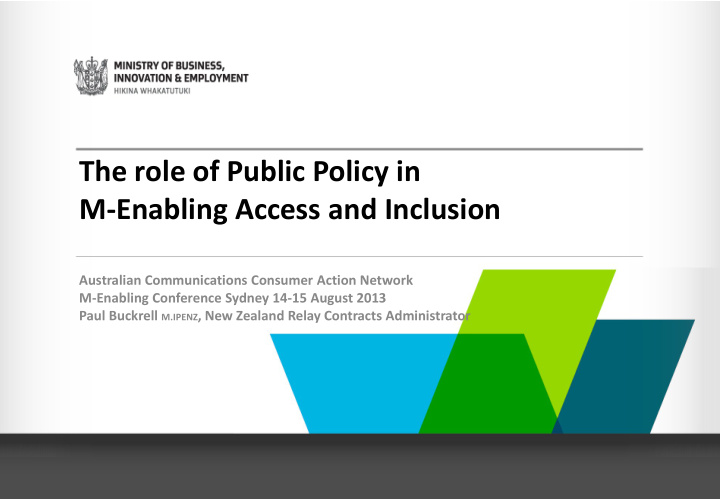



The role of Public Policy in M-Enabling Access and Inclusion Australian Communications Consumer Action Network M-Enabling Conference Sydney 14-15 August 2013 Paul Buckrell M.IPENZ , New Zealand Relay Contracts Administrator
Input sources to NZ policy on services for communications impaired people • Public consultation • New Zealand Relay Advisory Group that has members from the Deaf, deafblind, hearing impaired and speech impaired communities, the parent of a child with a communications disability, the CEO of the TCF and our Relay provider • Consult counterpart authorities in: – Australia – Norway – Sweden – United Kingdom – United States of America
Relevant legislation • Rather than one overarching law, our approach is to include the interests of people with disabilities within all legislative responses - health, education, social assistance, transport and housing. This approach underlines the responsibility of society to design systems and services that are accessible to all people, including people with disabilities. • Human Rights Act 1993, that protects the rights of people with disabilities, along with all New Zealanders, and guards against discrimination on the grounds of disability • NZ Sign Language Act 2006 that made NZSL New Zealand’s third official language • Telecommunications Act 2001 that contains the regulatory framework for the Telecommunications Relay Service (TRS) • Ratified the U.N. Convention on the Rights of Persons with Disabilities
Advantage of no relay services specific legislation • New Zealand has noted the problems of fraud that arose in some US relay services because Relay Assistants are required by the Americans with Disabilities Act to relay calls that they identify as being fraudulent • NZ Relay Assistants are authorised to terminate calls that they identify as fraudulent • NZ Relay has: – earned the trust of the user and business communities – never had a breach of privacy
Reality check for small countries • Cannot influence manufacturers of mass market devices • Rely in large part on the US FCC to e.g. mandate hearing aid compatibility with mobile devices for use in the US market
Changing from an analogue to a digital and wireless world • Disabled consumers need functionally equivalent telephone services: – For Deaf; Video Relay Service and mobile IP relay – For hearing impaired; Captioned Telephone Service (CTS) – For speech impaired; Speech to Speech and Hearing Carry Over
Transition • Video Relay Service is marginal over 3G but the service providers are moving to 4G so no government regulatory intervention is necessary in the wireless space • Mobile CTS is available on current 3G technology although its uptake will be relatively low compared to CTS from purpose-built telephones until the next more tech savvy generation start to lose their hearing • People who rely on very specialised devices, e.g. deafblind, risk being marginalised again if the functionality of their current analogue devices is not replicated in digital terminals. Tablets and gorilla glass are not tactile but a range of apps mitigate this.
The New Zealand position • Started in 2004 with: – voice to text and text to voice relay – Internet Relay – A trial of Speech to Speech (became permanent within 18 months) • Trialled VRS for 18 months starting June 2009 before making it permanent with a government funding cap and operating hours 9am to 5pm weekdays to support Deaf into and retaining employment. • Introduced CTS March 2013 as a functionally equivalent telephone service with a lower long run cost per minute than Voice Carry Over • Launching a Video Remote Interpreting service 30 Sept 2013 to improve access for Deaf to government services • Launching Mobile IP relay 1 October for Blackberry, Apple and Android devices
Government subsidised devices • Intervention only to make low volume devices that require adaptation to NZ network standards accessible: – Textphones (100% subsidy) – Voice Carry Over phones (100% subsidy) – Captioned Telephones (50% subsidy) – Telebraillers (100% subsidy) • No subsidies for mobile or computing devices because they are readily available from a range of suppliers
Recommend
More recommend